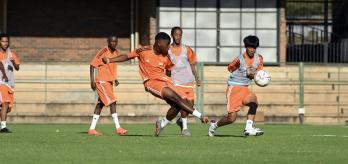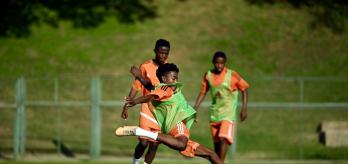Methodology
The intention: What is practised?
The main objective of this attack v. defence exercise is to enhance players’ ability to create and finish within a narrow focus. The drill places particular emphasis on player actions and requires players to identify the right moment to break the defensive line with a well-timed through-ball. Non-ball-carrying players are tasked with anticipating when to play on the last defender’s shoulder, when to drop to receive and draw in opponents, and when to find space behind pressing players to open up passing lanes to receive a defence-splitting pass. Receiving players should adopt an open body shape, which helps team-mates to understand which foot to pass to and the space a team-mate intends to move into. Defensive actions are also worked on in the exercise, including a player’s ability to press from the front to prevent forward passes.
The scale: For whom is this relevant?
The exercise revolves around the player and focuses on their ability to play a key pass or make a run in behind to penetrate a high defensive line. The drill is particularly relevant to midfielders operating in central areas and pockets of space in front of the opposition’s second defensive line, such as the number 6 or 8 or a number 10 who drops in, and attacking players anticipating a run in behind, e.g. the number 7, 9 or 11. When occupying a deeper role during the exercise, players are encouraged to use short, sharp movements and passes to break the second line of press and try to spring into attack. When occupying a position in the front line, players act as a number 7, 9 or 11 and can either drift into pockets of space in front of the defensive line to receive a pass that eliminates the first line of press or wait to make a run in behind. The coach acts as a support player positioned outside of the opposition’s shape, simulating the role of a centre-back.
The practice type: How is the practice designed?
The drill involves an attack v. defence game, featuring varied repetition that provides ample opportunities for players to practise breaking through a press. The narrow exercise area and the opposition’s high press mean that the focus is on short, incisive movements and actions as opposed to longer switches of play. The objective for the attacking team in the first zone is to draw opposition players in by circulating possession. Attacking players’ decision-making is tested, and they are tasked with recognising when they have managed to disrupt a defensive line and create space to play into. Attacking players should be aware of the offside line, which helps them to improve the efficiency of their runs timed in behind in a match-realistic scenario. Players are not allowed to drive with the ball to progress possession beyond the first zone, which increases the number of passes required to advance into the final zone. The exercise is non-position-specific, with all players rotating positions and asked to perform the same tasks.
Session plan
Organisation
-
Mark out a 40x20m exercise area.
-
Position a full-size goal at one end of the exercise area and 2 minigoals at the opposite end.
-
Place a goalkeeper in the full-size goal.
-
Divide the exercise area into 2 zones, as indicated in the graphic above.
-
Set up a 3v3 (attack v. defence) inside the first zone.
-
The coach occupies a position between the minigoals.
Explanation
-
The exercise begins with the coach, who supports the attacking team as a joker, playing the ball to an orange-team player.
-
The orange team’s objective is to retain possession inside the first zone and break through the blue team’s press by playing a through-ball into the final zone before finishing into the full-size goal.
-
The blue team press and try to win the ball inside the first zone. If they manage to do so, they attempt to score in either of the minigoals.
-
Players on both teams can only enter the final zone once the ball has crossed the offside line, i.e. the line that marks the end of the first zone.
-
Attacking players cannot dribble the ball from the first zone into the final zone.
-
Each time the sequence ends (i.e. a goal is scored, the goalkeeper makes a save or the ball goes out of play), play restarts with the coach.
Roles of coaches
-
First coach - Leads the exercise and plays an active role as the joker.
-
Second coach – Not present.
-
Third coach – Not present.













































